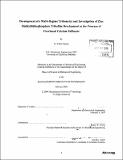| dc.contributor.advisor | Victor W. Wong. | en_US |
| dc.contributor.author | Kariya, H. Arthur (Harumichi Arthur) | en_US |
| dc.contributor.other | Massachusetts Institute of Technology. Dept. of Mechanical Engineering. | en_US |
| dc.date.accessioned | 2009-08-26T17:09:17Z | |
| dc.date.available | 2009-08-26T17:09:17Z | |
| dc.date.copyright | 2009 | en_US |
| dc.date.issued | 2009 | en_US |
| dc.identifier.uri | http://hdl.handle.net/1721.1/46636 | |
| dc.description | Thesis (S.M.)--Massachusetts Institute of Technology, Dept. of Mechanical Engineering, 2009. | en_US |
| dc.description | Includes bibliographical references. | en_US |
| dc.description.abstract | A custom tribometer was developed to investigate the production of nano-scale films from the anti-wear additive zinc dialkyldithiophosphate (ZDDP). The tribometer was designed to operate in various conditions of lubrication severity, from boundary to hydrodynamic lubrication regimes. A cylinder-on-plate layout, in which a cylinder rotates and rubs against a plate in a line contact, was employed for this purpose. ZDDP, a wear preventative additive universally used in engine and gear oil formulations, was studied in detail with respect to tribofilm production. As typical oil formulations contain an assortment of additives, the development of these films in the presence of other additives was studied. Of these, overbased detergents have recently been under scrutiny with mixed findings of synergetic and antagonistic effects. This project investigates the effects of overbased calcium sulfonate, a basic detergent used to neutralize acids and solubilize contaminants in oil, using electrical contact resistance (ECR), Auger electron spectroscopy (AES) and 31-phosphorous nuclear magnetic resonance (P₃₁NMR). Oil blends of 2.4% (mass) ZDDP with varying concentrations of calcium sulfonate were mixed for rubbing and heating tests. ECR was used to monitor the development of the tribofilm in-situ of the tribometer and AES was used in postmortem analysis to measure the film thickness. Analysis with P₃₁ NMR was employed for a series of heating experiments to characterize the chemical interactions between the two additives. Tests in light boundary lubrication show a trend of suppression of ZDDP tribofilm formation with the introduction of the detergent. | en_US |
| dc.description.statementofresponsibility | by H. Arthur Kariya. | en_US |
| dc.format.extent | 104 p. | en_US |
| dc.language.iso | eng | en_US |
| dc.publisher | Massachusetts Institute of Technology | en_US |
| dc.rights | M.I.T. theses are protected by
copyright. They may be viewed from this source for any purpose, but
reproduction or distribution in any format is prohibited without written
permission. See provided URL for inquiries about permission. | en_US |
| dc.rights.uri | http://dspace.mit.edu/handle/1721.1/7582 | en_US |
| dc.subject | Mechanical Engineering. | en_US |
| dc.title | Development of a multi-regime tribometer and investigation of zinc dialkyldithiophosphate tribofilm development in the presence of overbased calcium sulfonate | en_US |
| dc.type | Thesis | en_US |
| dc.description.degree | S.M. | en_US |
| dc.contributor.department | Massachusetts Institute of Technology. Department of Mechanical Engineering | |
| dc.identifier.oclc | 426488999 | en_US |
